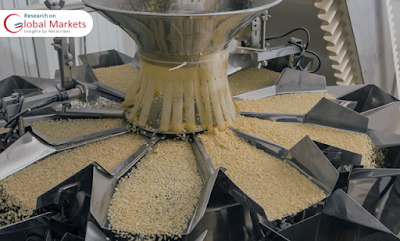For a long time, the term ‘processed foods’ were seen by many with certain disdain, suggesting the fact that processed foods are somewhat inferior to their non-processed counterparts. However, it is important to remember that food processing has been used for centuries, and it greatly facilitates provision of safe food to populations around the globe. It was not until very long that processed, preserved foods became widely available in India, and the food processing market in India gained significant prominence.
 |
| Food Processing Market in India |
Benefits of food processing –
Safety – One of the biggest benefits of processing foods is that it allows the food producers to ensure food safety and remove or prevent dangerous toxins. Milk pasteurization is a good example of food processing as it removes harmful bacteria from raw milk, making it suitable for human consumption. Food processing methods that remove water, such as drying and smoking, reduce or limit the possibility of bacterial growth because the bacteria rely on the water to grow and multiply.
Preservation – Once food is processed, it invariably make them far easier to store and preserve. Some food processing techniques, such as freezing, preserve the nutritional content. Other methods, such as cooking, can also improve nutritional content. Moreover, preserved food can be stored for longer time periods compared to non-preserved foods, making them convenient for consumers to consume and do away with frequent purchases.
Food processing allows consumers to enjoy a varied diet that is compatible with the fast pace and lifestyle of the modern day society. People are always on the move, and are exposed to a wider selection of flavours and styles of foods. Individuals are also changing the way they spend their time, and many choose not to cook foods from scratch. To meet consumer expectations, manufacturers are therefore producing sophisticated foods of restaurant quality, or from far-away countries to cook and enjoy in our own homes.
Our related post:
What are the high growth Segments of the Food Processing Market in India?
What are the methods present in the food processing market in India?
Factors Contributing to the Growth of the Food Processing Market in India
What are the key growth drivers of the Food Processing Market in India?
Safety – One of the biggest benefits of processing foods is that it allows the food producers to ensure food safety and remove or prevent dangerous toxins. Milk pasteurization is a good example of food processing as it removes harmful bacteria from raw milk, making it suitable for human consumption. Food processing methods that remove water, such as drying and smoking, reduce or limit the possibility of bacterial growth because the bacteria rely on the water to grow and multiply.
Preservation – Once food is processed, it invariably make them far easier to store and preserve. Some food processing techniques, such as freezing, preserve the nutritional content. Other methods, such as cooking, can also improve nutritional content. Moreover, preserved food can be stored for longer time periods compared to non-preserved foods, making them convenient for consumers to consume and do away with frequent purchases.
Food processing allows consumers to enjoy a varied diet that is compatible with the fast pace and lifestyle of the modern day society. People are always on the move, and are exposed to a wider selection of flavours and styles of foods. Individuals are also changing the way they spend their time, and many choose not to cook foods from scratch. To meet consumer expectations, manufacturers are therefore producing sophisticated foods of restaurant quality, or from far-away countries to cook and enjoy in our own homes.
Our related post:
What are the high growth Segments of the Food Processing Market in India?
What are the methods present in the food processing market in India?
Factors Contributing to the Growth of the Food Processing Market in India
What are the key growth drivers of the Food Processing Market in India?








